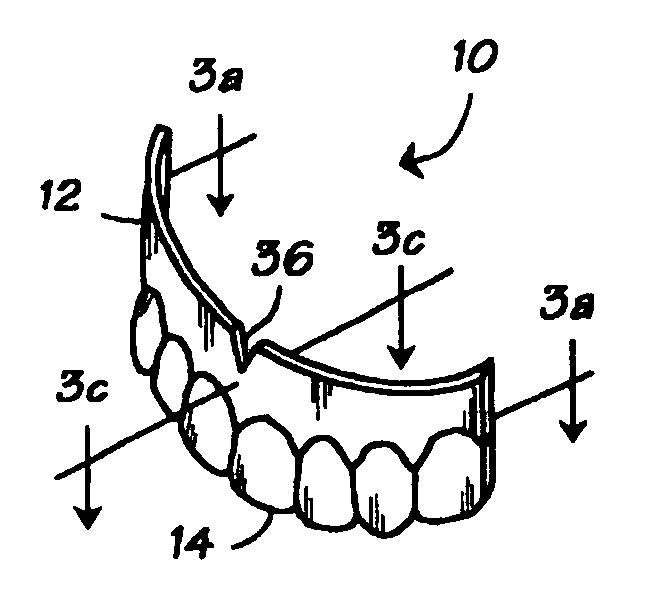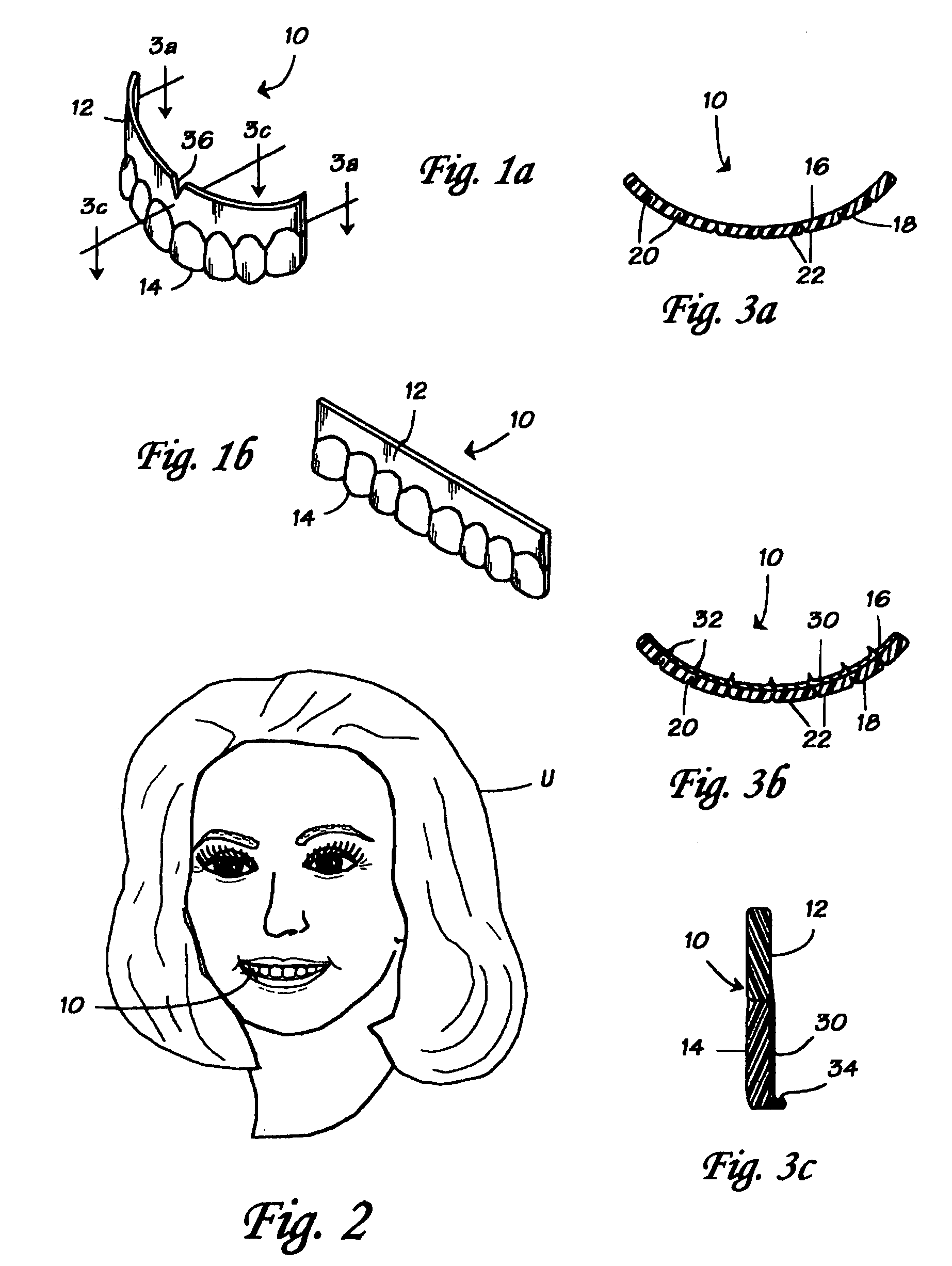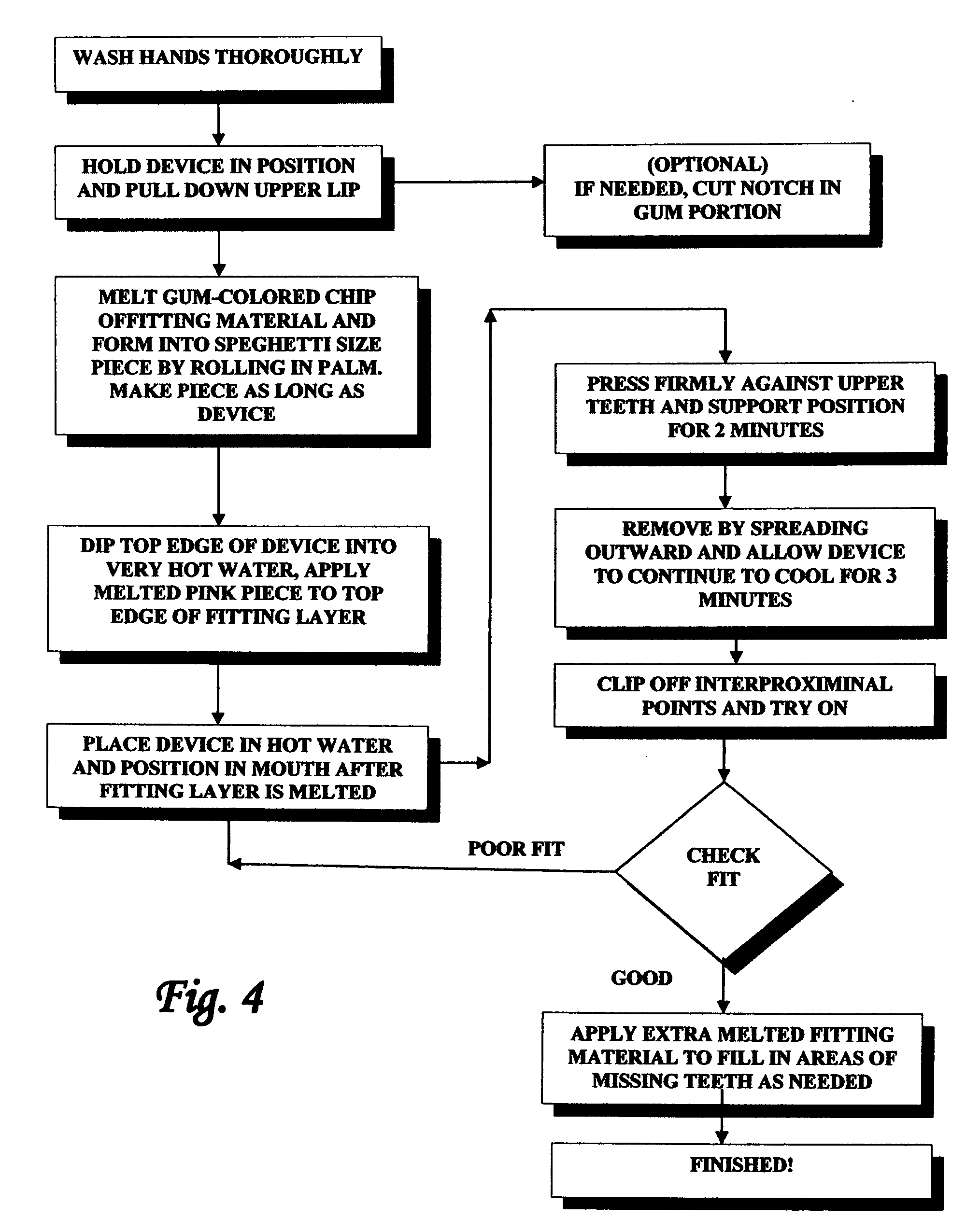[0017]According to its major aspects and broadly stated, the present invention is a removable cosmetic accessory device that simulates the appearance of an assemblage of teeth and gums. The present invention is an improvement over the cosmetic accessory device for teeth which was granted to Albert et al in U.S. Pat. No. 5,951,291. The present device includes a gum portion and a tooth portion which is shaped and dimensioned to cover the user's front teeth and at least a portion of the gums. To enhance the user's appearance, the tooth portion is preferably shaped to resemble attractive natural teeth. However, if desired, the tooth portion may simulate the appearance of unsightly teeth for a convincing theatrical disguise. In a preferred embodiment of the invention, the device is in the form of a somewhat flexible shell that is custom fitted to an individual user with a room-temperature-curable
polymer material.
[0019]In a preferred embodiment of the invention, the fitted device is a thin, somewhat resilient and somewhat flexible shell with an approximately semicircular cross section. When properly fitted for wearing its inner layer surface, which is molded to match the user's
dentition, mechanically holds the device in place in the user's mouth. Unlike conventional
dentures and dental accessories, a device according to the invention covers only the labial surfaces of the user's natural teeth and gums, so it is comfortable to wear and does not interfere with natural speech or bite closure.
[0020]Another important feature of the present invention is the selection of materials used for making the device. The device is made of nontoxic, somewhat resilient, chemically stable materials that are tasteless, odorless, easily cleaned, and do not stick to natural teeth, gums, or most dental work (fillings, crowns, bridges, etc.). Preferably, the device is made of two portions of a similar material which are fused together to form an outer labial shell which is then attached to a thin fitting portion of material which is made of a workable
thermoplastic resin. The outer labial shell is made of a
thermoplastic polyurethane (TPU). The materials are medical or
food grade approved, and have high tear strengths. In addition, extra
thermoplastic resin fitting material is provided in an envelope for the user to fuse extra material into spaces where teeth are missing to serve as a
fastener and spacer. Additionally, the extra fitting material will stiffen the device where two or more adjacent teeth are missing. A wide range of materials with the requisite properties are broadly suitable for use with the invention. Preferably, the fitting portion of the device is should be stiffer (more rigid) and possess a higher
flexural modulus than the outer labial shell materials so that different arch sizes can be fitted.
[0021]Another feature of the present invention is the fitting portion of the device, which serves to maintain the position of the device in use. The fitting portion includes custom fitted matching surfaces, or imprints of the user's teeth. Optionally, the inner
lingual surface of the outer labial shell is provided with a ledge or shelf which maintains the device's position during normal wear but is generally concealed from view. The tooth portion is dimensioned to cover the upper front teeth, preferably those teeth that are most visible when the wearer smiles (the incisors and canines, and preferably also the first premolars, i.e., the premolars immediately adjacent to the canines). Depending on the
cosmetic appearance of the tooth portion, the device may be worn as an accessory to enhance the user's appearance and foster increased self-esteem, as an amusing disguise to entertain the user and others, as a theatrical accessory, or as a
teaching tool to demonstrate the results of planned dental treatment.
[0023]There are significant improvements of the present invention over the previous invention disclosed by Albert et. al. in U.S. Pat. No. 5,951,291. The user can simply place the device in hot water and refit again that if the first fit is not comfortable. This is because the cured
thermoplastic polymer material used in the present invention allows refitting whereas the cured
silicone used in the previous invention could not be refitted after curing to
room temperature. There is no
silicone used in the present invention. Another improvement over the previous invention is the ability to fuse extra fitting material into the inner or fitting layer to make projections into areas where teeth are missing. The extra fitting material functions as a spacer (keeps neighboring teeth from shifting) as well as acting as male snap type
fastener to increase the security of the fit. This could not be done with the previous invention due to the properties of
silicone.
 Login to View More
Login to View More  Login to View More
Login to View More 


